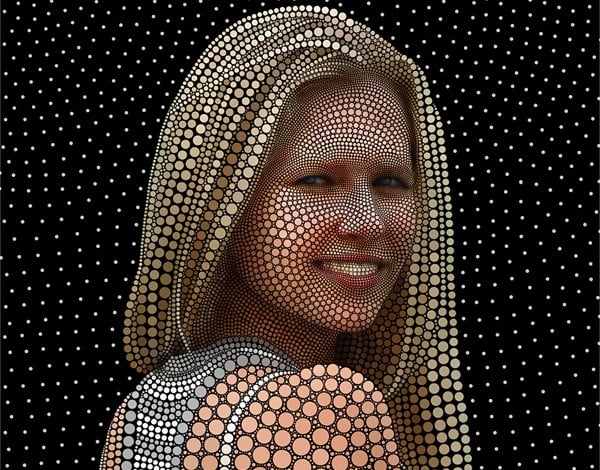
John Liebenberg, South African withdrawal from Angola (1988).
Photo: © John Liebenberg via Guernicamag.com.
1. “A Failure of Memory” by Ingrid Sinclair, Guernica
In the shadow of the recent wave of anti-immigrant violence in South Africa, a photo show at the Nelson Mandela Centre of Memory in Johannesburg gathers still images documenting the country’s own role in destabilizing its neighboring states. Sinclair, a documentary filmmaker, brings together testimony from the photographers who bore witness to the conflict.
Miriam Schapiro in 1977.
Photo: via www.bluffton.edu.
2. “An Inquiry Into What Women Saved and Assembled — Femmage” by Miriam Schapiro and Melissa Meyer, ArtCritical
Schapiro, a foundational figure for feminist art, passed away last month. ArtCritical reprints her classic text from Heresies on women and collage, with a short, heartfelt remembrance from her co-author, Melissa Meyer, as an introduction.
Installation view of Robert Motherwell, “Opens,” at Andrea Rosen Gallery.
Photo: Courtesy of Andrea Rosen Gallery.
3. “Another Look at Robert Motherwell” by John Yau, Hyperallergic
Yau’s piece is a characteristically assured consideration of the themes of late Motherwell, framing his baffling “Opens” series, recently shown at Andrea Rosen, as a subtle exploration of what Abstract Expressionist painting could do after Minimalism and the other movements of the 1960s.
4. “Belaboring the Fringe: In Lieu of an Artists Statement” by Gelare Khoshgozaran, Temporary Art Review
Passing through her own experience both in Iran and as a grad student at USC’s Roski School of Art, Khoshgozaran offers a glimpse of alternative, politically engaged conversations about the stakes of art growing up on the borders and between the lines of the official scene.
Still from The Yes Men Are Revolting.
Photo: via TheYesMen.org.
5. “Beyond Clicktivism: Why Political Change Requires Risk” by the Yes Men, Creative Time Reports
The Yes Men are originals of the Internet art-and-activist scene. So it means something that, in this piece, they forcefully remind their many followers that you really have to get out into the world if you want to change it.
6. “Same as It Ever Was: A Conference on Art Criticism in the Digital Age” by William S. Smith, Art in America
Last month, I spoke at the Walker Art Center’s “Superscript” conference. Here, Smith gives a smart, critical overview of what was at stake in the many conversations that came out of that weekend of art critics talking about being art critics.
Ben Heine’s She Is My Mona Lisa (2010), an illustration from “Styles and Customs in the 2020s.”
Photo: via e-flux.com.
7. “Styles and Customs of the 2020s” by DIS Magazine, Supercommunity/e-Flux
The brains of e-Flux went to Venice in May to curate a sprawling publishing initiative for the city’s Biennale, bringing together a variety of writers into something called the “Supercommunity.” Any number of Supercommunity texts are worth your time; I pick DIS Magazine’s sassy exercise in futurology simply because it is the most fun.
8. “Taking the Measure of Sexism: Facts, Figures, and Fixes” by Maura Reilly, ARTnews
By far the most-talked-about text of June (see my own Why Are There Still So Few Successful Female Artists?), Reilly’s well-researched piece serves as the State-of-Sexism-in-the-Art-World address required to keep the issue in the spotlight.
Michelangelo Pistoletto in the Havana Biennial.
Photo: via the Havana Biennial website.
9. “The 12th Havana Biennial’s Neoliberal Turn” by Mostafa Heddaya, Artinfo
Scrutinizing the presences and absences in the current art spectacular for indications of the shifting cultural politics of the Cuban thaw.
El Chaco meteorite in Argentina, as seen in Documenta (13).
Photo: via documenta.de.
10. “Those Obscure Objects of Desire” by Andrew Cole, Artforum
Remember when Carolyn Christov-Bakargiev framed her Documenta by musing aloud about the needs and desires of a meteorite? Cole offers a righteous, scholarly takedown of the vogue for “Object-Oriented Ontology” in contemporary art theory, exposing it as the vaguely goofy animism that it is.
The first issue of Artenol.
BONUS:
This month, Russian jokester Alexander Melamid launched Artenol, an art publication aiming to be “for spectators written by spectators in prose that is both readable and literary.” The inaugural issue is actually die-cut to resemble the thickly mustached profile of “death of god” philosopher Friedrich Nietzsche. Its website doesn’t look so bad either.